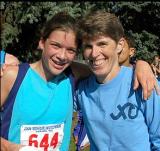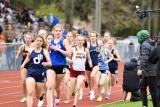Folders |
Running Issues: On International Women's Day, Five Thoughts About How To Level Race CoveragePublished by
A Playbook For Improving Exposure And Boosting The Sport By Elizabeth Carey for DyeStat/John Nepolitan photo What if we celebrated women's athletic achievements as much as men’s? While International Women’s Day seems as good a day as any to imagine equal coverage, the reality is sports coverage falls drastically short. In 2019, television coverage of sports news and highlights included a mere 5.4 percent focused on women athletes, according to Purdue University. That’s about the same as it was in 1989, and includes a chunk of coverage of the 2019 Women’s World Cup. @Keeping Track Media Running and track and field, by my wholly unscientific assessment, seems uniquely suited to closing some of that big gap. But it still falls short of covering each competitive division equally — especially when we watch global big-time events like marathons. Covering real-time competitions can get complicated, especially road races which wind for miles through congested urban areas. Broadcasters (sports media outlets with the rights to air an event) often contract the filming task out to varied production companies, which have wide-ranging skillsets, standards, and experience. With international marathons, for example, production companies may have different priorities than in what a U.S. audience is looking for, and therefore not include equal coverage of men’s, women’s, and parathlete divisions. Syndicators (outlets that pay to stream an event) also get stuck with whatever feed they bought the rights to. Commentators, whose voices talk us through the event, may sit in a box at the finish line or the lead car that hovers around one division’s lead pack or runner. (The good ones have done their research and provide context, spelling out what fans can’t see or may not know.) Increasingly, however, sports announcers call events remotely; the pandemic accelerated a trend that keeps announcers off-site. Reporters and live-Tweeters may be typing from a media room either on-site or afar, watching the same live feed, or plopped on a lead vehicle. Either way, the folks whose job it is to translate what, exactly, is happening, have similar constraints. If a world feed editorial team doesn’t capture the women’s ambulatory parathlete start, well, your local channel can’t show it. Globally, fans see and hear different coverage, based on their streaming options and access. But we — fans, elite athletes, coaches — are sick of excuses. Our sport suffers when we short-change elite women’s fields and other marginalized divisions, including wheelchair and parathlete ambulatory divisions. It’s time producers, broadcasters, sponsors, agents, fans, and anyone else with a vested interest called for higher, more equitable standards.
Here are five ways to improve the coverage of elite road races. Psst, it starts well before race day, but I'll start with the event itself. 1. Give each division a separate, or at least equal, start with airtime. Can a fan see the top women standing shoulder-to-shoulder on the starting line? Or are they buried by a bunch of average men who’re trying to qualify for Boston? Can a fan see the wheelchair athletes fly off the line at the sound of the starter’s gun? 2. Show every race. When the women’s race is unfolding, show us. We want to see the moves being made! It’s 2022; use split-screen and screen-in-screen technology to show live feeds of concurrent races, so each division is included. Feature a ticker tape and/or a column graphic that shows the current order of racers. You can also highlight the leaders’ most recent split times. 3. Show the finish line. When each division is crossing the finish line, show us. Again, use split-screen and screen-in-screen technology to show at the very least the top three finishers from each division sprinting or staggering or smiling as they complete the race. Update your ticker tape and/or column graphic as they finish. These are things you can keep rolling through post-race interviews!
4. Media, be mindful. This is a reminder for myself as much as anyone else. What implicit bias is present when we’re talking about athletes? Do we talk about the dads as much as the “supermoms”? Are we as focused on the parathletes as other divisions? Can we pronounce and spell athletes’ names correctly? Are we using their preferred pronouns? If language is a barrier, can we tap translators? What vocabulary — or potentially loaded words — do we choose? @Keeping Track Media Do those with press passes look homogeneous? What about producers, executives, commentators? Are those groups representative of the sporting population in background, identity, experience? Are record-breaking or world-leading performances unfolding? Shout. It. Out. 5. Pre-race, there’s a lot race organizers can do to set up an equitable, inclusive, and exciting event. Split the prize purse equally among divisions; advertise that. Highlight women, wheelchair, and parathlete divisions in pre-race marketing — images, press releases, media kits, press conferences. Include bios for all elite racers (and target media outreach accordingly) so reporters and commentators know who’s who. Cover travel, lodging, and meal fees equally across divisions, something organizers of the 2020 U.S. Olympic Marathon Trials in Atlanta prioritized, with a smashing success of the historically enormous women’s field. Consider equity and inclusion when cutting checks for appearance fees. Work with broadcasters to facilitate consistent, thorough coverage. Test for performance-enhancing drugs. And shoes. JK. Kind of. That’s a whole other can of worms I’ll kick down the road. If you’ve been on Twitter during a World Marathon Major race or even a last-minute qualifying track meet or the Olympics, you know ideas about how to improve event coverage abound. (Keep them coming.) But change can start today, with equitable consideration. ### Elizabeth Carey (https://elizabethwcarey.com/) is a writer and running coach based in Seattle, Washington. Her first book, GIRLS RUNNING, co-authored with Melody Fairchild, is available at your local bookstore and here: https://shop.aer.io/GirlsRunning/p/Girls_Running_All_You_Need_to_Strive_Thrive_and_Run_Your_Best/9781948007184-9934. More news |







